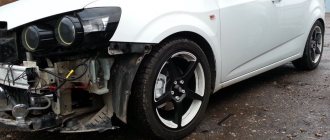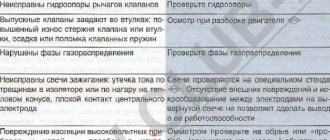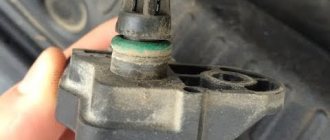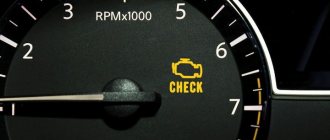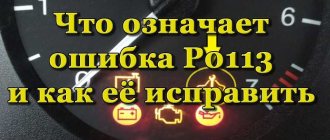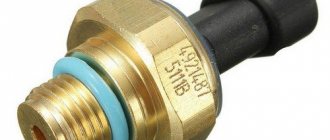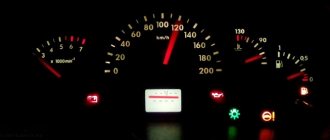Let's briefly consider why error P0597 occurs on the Chevrolet Aveo t300 and what it can lead to if the problem is not corrected in time. First, about the sad things. By ignoring error 89 (P0597), we jeopardize the temperature conditions of the engine. This is fraught not only with frequent overheating, but also with the failure of a number of parts:
- the expansion tank of the cooling system cracks due to high temperatures;
- hoses and pipes crack;
- antifreeze works in borderline mode and wears out faster;
- the plastic housing of the Chevrolet Aveo t300 thermostat is not durable anyway, and at high temperatures it begins to leak literally a couple of thousand km after the error appears;
- Well, the engine also has a hard time due to temperature violations.
The electronic engine control unit controls the thermostat using pulse width modulation signals. An antifreeze heater is installed in the thermostat housing of the Chevrolet Aveo t300. It is he who regulates the flow of coolant and controls the operating temperature.
The ECU must constantly supply 12 V to the thermostat and control the heater by connecting it to engine ground. The connection is made via a semiconductor signal conditioner. It has a feedback circuit connected to a common 12V supply.
The engine control unit controls the entire device by reading the heater feedback voltage. Thanks to this scheme, the ECU easily calculates the performance of the entire thermostat and can detect both a short circuit to ground and an open circuit, which will signal the driver with a fault code. And yet, if we have a scanner or PC at hand, in addition to error P0597, we can receive accompanying error codes - P0598 and P0599.
These are clarifying codes that can be deciphered something like this:
- P0597 - open circuit in the thermostat heater circuit.
- P0598 - thermostat heater voltage is too low.
- P0599 - overestimated voltage readings.
In a word, it is clear that when code 89 or error P0597 appears on the BC display on the Aveo T300, our task is to check or get rid of the antifreeze heater, if possible.
Chevrolet Aveo T300 code 24 what does it mean
Error Codes 15 High Brake Light Malfunction 16 Perform Brake Light Service 18 Left Headlight Low Beam Malfunction 19 Rear Fog Light Malfunction 20 Right Low Beam Malfunction 21 Left Front Parking Light Malfunction 22 Right Front Parking Light Malfunction 23 Reversing Light Malfunction 24 Malfunction license plate light 25 Malfunction of the left front turn signal 26 Malfunction of the left rear turn signal 27 Malfunction of the right front turn signal 28 Malfunction of the right rear turn signal 84 Engine power has decreased 89 The vehicle will require regular maintenance soon
THESE ERRORS ARE ALL OVER THE CAR:
Error codes for Chevrolet Lacetti, Rezzo, Aveo, etc. Diagnostic trouble codes (1.4 l / 1.6 l)
P0030 HO2S (sensor 1) Heater circuit inoperative P0036 HO2S (sensor 2) Heater circuit inoperative P0107 Manifold absolute pressure sensor low signal P0108 Manifold absolute pressure sensor high signal P0112 Intake air temperature sensor low signal P0113 Intake Air Temperature Sensor High P0117 Coolant Temperature Sensor Low P0118 Coolant Temperature Sensor High P0122 Throttle Position Sensor Low P0123 Throttle Position Sensor High P0131 HO2S (Sensor 1) P0132 HO2S Signal Low (Sensor 1) P0133 HO2S Signal High (Sensor 1) P0137 HO2S Signal Low (Sensor 2) P0138 HO2S Signal Low (Sensor 2) P0140 HO2S Signal High (Sensor 2) Circuit or Signal Failure P0171 Fuel trim system too lean P0172 Fuel trim system too rich P0222 Idle throttle control actuator circuit low P0223 Idle throttle control actuator circuit high P0261 Cylinder 1 injector circuit low P0262 Cylinder 1 Injector Control Circuit High P0264 Cylinder 2 Injector Control Circuit Low P0265 Cylinder 2 Injector Control Circuit High P0267 Cylinder 3 Injector Control Circuit Low P0268 Cylinder 3 Injector Control Circuit High P0270 Cylinder 4 Injector Control Circuit Low P0271 Cylinder 4 Injector Control Circuit High P0300 Multiple Misfire Detected P0327 Knock Sensor Circuit Malfunction P0335 Crank Position Sensor P0336 Crankshaft Position Sensor Pulse Error P0337 Crankshaft Position Sensor No Signal P0341 Camshaft Position Sensor Out of Range P0342 Camshaft Position Sensor No Signal P0351 Ignition Control Circuit 1 & 4 Malfunction P0352 Circuit 2 Malfunction and 3 ignition controls P0400 EGR, out of control P0401 EGR, EGR valve blocked P0403 EGR valve circuit failure P0404 EGR, EGR valve faulty P0405 EGR feedback circuit low or open P0406 EGR feedback circuit high or open P0420 Converter efficiency low P0444 Canister purge valve circuit, no signal P0445 Canister purge valve circuit failure P0462 Fuel level sensor, low on
Source
Reviews
To better understand the features of the Chevrolet Aveo, it is worth citing reviews from car enthusiasts.
Ivan, 37 years old, Chevrolet Aveo, 2007.
“I bought the car in 2008, fully equipped (except for climate control and automatic transmission).
The 1.4 liter engine is slightly “gluttonous”. Although, when the air conditioner is turned on, the consumption increases.
The engine is playful, the long second gear is pleasing, allowing you to reach up to 120 km/h (for a short period of time). “Cruising” speed is 110 km/h. At higher speeds, driving becomes uncomfortable, the steering wheel loses its information content.
The maximum speed at which the car was able to accelerate was 180 km/h (I didn’t dare to go any further).
I was upset by the thin metal of the body part, which bends even under light pressure. In all other respects there are no complaints. The Chevrolet Aveo is a great option for families and long trips.”
Nikita, 40 years old, Kursk, Chevrolet Aveo, 2008.
“What attracted me to the car was its simplicity of design and maintainability. Already in the first two years I drove 25 thousand kilometers.
The only thing that had to be changed was the release bearing (under warranty).
At 70,000 the radiator leaked and the suspension began to knock. After another 10,000, I changed the rear silent blocks.
I like the car's handling, modern design, comfort, decent sound insulation (up to 100 km/h).
There are no problems with repairs - there are enough spare parts on the market.”
Nikolay, 28 years old, Stavropol, Chevrolet Aveo, 2014.
“I decided to buy the car precisely because of the design - I really liked it. But the technical part of the T300 also did not disappoint.
The engine pulls confidently and the gearbox works smoothly. The small efforts that have to be made when engaging gears do not spoil the overall impression.
The steering is informative, the seat is comfortable. The downside is the stiff suspension, but you quickly get used to it.”
Igor, 48 years old, Moscow, Chevrolet Aveo, 2022.
“After purchasing the Chevrolet Aveo T300 I was in seventh heaven. The car lived up to expectations and became a true friend for the family.
After two years of operation, I can note the high-torque engine, handling, and good suspension, which is adapted to our roads.
For this money it is difficult to find a better option. The safety of the car is also top notch.”
To summarize, we can say that the Chevrolet Aveo has become a people's car in Russia, and it does not matter in what variations it is purchased, T 250 or T 300.
An acceptable price for a car, good performance characteristics, availability of auto parts, which indicates its maintainability, all this speaks of one thing: the Chevrolet Aveo will remain a popular car in Russia for a long time.
If you are the owner of such a car and already have some experience in its operation, and are ready to share it with our readers, leave your notes in the comments. Your experience will be useful to many.
T300 Error Codes
15 High brake light malfunction 16 Perform brake light service 18 Left low beam malfunction 19 Rear fog lamp malfunction 20 Right low beam malfunction 21 Left front parking light malfunction 22 Right front parking light malfunction 23 Reverse lamp malfunction 24 Backlight malfunction ki license plate number 25 Left front turn signal faulty 26 Left rear turn signal faulty 27 Right front turn signal faulty 28 Right rear turn signal faulty 84 Engine power reduced 89 Vehicle will need to be serviced soon
P0030 HO2S (sensor 1) Heater circuit inoperative P0036 HO2S (sensor 2) Heater circuit inoperative P0107 Manifold absolute pressure sensor low signal P0108 Manifold absolute pressure sensor high signal P0112 Intake air temperature sensor low signal P0113 Intake Air Temperature Sensor High P0117 Coolant Temperature Sensor Low P0118 Coolant Temperature Sensor High P0122 Throttle Position Sensor Low P0123 Throttle Position Sensor High P0131 HO2S (Sensor 1) P0132 HO2S Signal Low (Sensor 1) P0133 HO2S Signal High (Sensor 1) P0137 HO2S Signal Low (Sensor 2) P0138 HO2S Signal Low (Sensor 2) P0140 HO2S Signal High (Sensor 2) Circuit or Signal Failure P0171 Fuel trim system too lean P0172 Fuel trim system too rich P0222 Idle throttle control actuator circuit low P0223 Idle throttle control actuator circuit high P0261 Cylinder 1 injector circuit low P0262 Cylinder 1 Injector Control Circuit High P0264 Cylinder 2 Injector Control Circuit Low P0265 Cylinder 2 Injector Control Circuit High P0267 Cylinder 3 Injector Control Circuit Low P0268 Cylinder 3 Injector Control Circuit High P0270 Cylinder 4 Injector Control Circuit Low P0271 Cylinder 4 Injector Control Circuit High P0300 Multiple Misfire Detected P0327 Knock Sensor Circuit Malfunction P0335 Crank Position Sensor P0336 Crankshaft Position Sensor Pulse Error P0337 Crankshaft Position Sensor No Signal P0341 Camshaft Position Sensor Out of Range P0342 Camshaft Position Sensor No Signal P0351 Ignition Control Circuit 1 & 4 Malfunction P0352 Circuit 2 Malfunction and 3 ignition controls P0400 EGR, out of control P0401 EGR, EGR valve blocked P0403 EGR valve circuit failure P0404 EGR, EGR valve faulty P0405 EGR feedback circuit low or open P0406 Exhaust Gas Recirculation Feedback Circuit High or Open P0420 Converter Efficiency Low P0444 Canister Purge Valve Circuit No Signal P0445 Canister Purge Valve Circuit Malfunction P0462 Fuel Level Sensor Low Voltage P0463 Fuel Level Sensor High Voltage P0480 Malfunction Cooling fan low speed relay circuit P0481 Cooling fan high speed relay circuit high P0501 Vehicle speed signal missing (manual transmission only) P0510 Throttle position switch circuit fault P0562 System voltage low P0563 System voltage high P0601 ECM checksum error P0604 ECM RAM Error P0605 ECM Write Error P0628 Fuel Pump Relay Circuit Low P0629 Fuel Pump Relay Circuit High P0646 A/C Compressor Relay Circuit Low P0647 A/C Compressor Relay Circuit High P0650 Malfunction Indicator Lamp , circuit low P0656 Fuel level output circuit malfunction P0661 Intake manifold actuator solenoid, circuit low P0662 Intake manifold actuator solenoid, circuit high P0700 TCM general fault, transmission malfunction (only automatic) P1390 Rough road sensor circuit failure (0.8S only) P1396 ABS Rough road sensor, incorrect data P1504 Vehicle speed signal missing (automatic only) P1610 Main relay circuit high P1611 Main relay circuit low P1628 Not installed communication with immobilizer P1629 Incorrect immobilizer calculation P1650 Malfunction indicator lamp, circuit high voltage P2101 Idle charge drive circuit malfunction P2118 Idle charge drive mechanical error P2119 Idle speed control functional error U0101 Transmission controller message missing (automatic only)
Source
Chevrolet Aveo T300 and 24 error codes. Deciphering and correcting
Download PDF
After some time of operation, owners have questions about what Chevrolet Aveo T300 and 24 error codes are. The on-board computer installed on modern cars is designed to control the car’s systems, and also informs the driver about any problems with the car.
This increases reliability and safety during operation, and also speeds up the process of detecting and eliminating faults. Chevrolet Aveo T300 and 24 error codes warn the owner that there is a problem in the vehicle systems. Knowing and being able to decipher the error codes that are displayed on the on-board computer display, you can easily decide what to do in such a situation. In some cases, you should stop moving, in other situations you can continue, but then fix the problem.
Troubleshooting Methods
Now that the main reasons have been identified - why the Chevrolet Aveo Check Light caught fire, you can move directly to methods for solving the issue. Of course, it is best to contact a car service to solve the problem, but many motorists, due to expensive repairs, try to solve the problem themselves.
So, before you start looking for a problem, you should connect to the electronic engine control unit and conduct a comprehensive diagnosis of all systems. To do this, you will need a laptop computer, a cable for connecting to the OBD 2 car and software that is suitable for this electronic control unit.
Having connected to the vehicle, it is necessary to carry out a comprehensive diagnosis of all systems, and then determine which errors have popped up and decipher them in order to determine the fault point. When everything is deciphered, you can proceed directly to troubleshooting.
A few words about car diagnostics
When previously unknown symbols and signs suddenly appear on the instrument panel, these are most likely messages from the on-board computer about problems that have arisen in one of the car’s systems. The ability to correctly decipher these messages allows you to promptly identify and get rid of problems that have arisen. With the advent of new Chevrolet models, decoding is becoming increasingly difficult, as their number increases.
For correct recognition, it is best to perform diagnostics using special equipment, or check messages on the car’s dashboard. Models have appeared in which a message is displayed instead of a code. For example, a message may appear indicating that the time for changing the engine oil is approaching, or other similar messages. To find out in more detail about the problems that have arisen, it is best to use a special scanner.
Fuel pump and filter
Along with low-quality fuel, the fuel pump and filter suffer. Basically, the contamination of these elements leads to the fact that fuel does not flow in the required quantity, and this in turn leads to the appearance of a lean mixture, which can lead to high consumption or poor engine starting.
To eliminate the problem, you will have to replace the fuel filter. As for the gasoline pump, you will have to remove it from the car and replace the filter mesh, which is probably clogged. This procedure must be performed carefully, since you can accidentally damage the elements of the fuel pump.
How are the codes deciphered?
As already noted, with each new car model, the number of codes increases. It is simply impossible to talk about all possible combinations in this article, so we will focus on some of them. There are a number of errors that occur most often, and some of them occur in extremely rare cases. It is advisable for car owners to print them out and take them with them in order to decide on the course of further actions at the right time.
An example is error P0300
, which reports multiple misfires. To get rid of this problem, you need to check the entire ignition system of the car. Control sensors are located in all major vehicle systems, so any malfunctions that arise do not go unnoticed.
Conclusion
Errors in the electronic control unit on the Chevrolet Aveo occur quite often. Typically, they are accompanied by a “Check Engine” indicator or a malfunction of one of the systems. So, eliminating errors with your own hands does not always end well, so you should be quite careful when performing the operation. If you are not sure that everything will go smoothly, it is recommended to contact a car service to avoid breakdowns.
You don't have to be a professional automotive diagnostician to read Chevrolet error codes. Having a diagnostic device, you can easily get a list of faults, and then decipher Chevrolet error codes using our list.
During self-diagnosis, the Chevrolet on-board computer (Chevrolet Niva, Captiva, Cobalt, Epica, Lacetti, Lanos, Aveo and others models) can display the following error and malfunction codes:
A few more words about error codes
Many owners are looking for an answer to the question of what code 24 means. This signal on the instrument panel indicates problems with the license plate lighting of the car. For such a malfunction you can be punished by a fine, so the malfunction must be eliminated. Let's look at this in more detail.
Since the license plate lights are connected to the vehicle's electrical system, you need to check the fuse in this circuit. A separate device is not installed for this circuit; usually it is a side light fuse. It is set to a current of 10 Amps
, so check this device first. However, I would like to immediately warn you that its failure does not always happen.
The wires that supply power to the backlights have too rigid insulation, so they break after frequent bending. Open the trunk and on the left side of the car, check the condition of the wiring. Usually a break is detected by touch, after which you should disconnect the white connector, eliminate the broken wire and put everything back in place.
The situation is somewhat worse when the break occurs near the connector itself. In this case, you will have to disassemble it to replace the wire in the connector terminal. But that's not all. The problem may be burnt out license plate light bulbs. In this case, you will also have to tinker, since in order to replace them, you need to disassemble the trunk panel. Only after this can faulty devices be removed and replaced.
As you can see, problems exist, but they are completely solvable, including with your own hands. Chevrolet Aveo T300 and 24 error codes are far from the only ones; there is also a fairly large list of them. Therefore, it is advisable for all owners to have it in their car for prompt response.
Source
Air supply system
A malfunctioning or clogged throttle body can cause your vehicle's check engine light to flash. In this case, in order to fix the problem, you will have to dismantle the air distribution unit and clean it.
It is worth noting that car mechanics recommend cleaning with a special liquid, but motorists can also use a regular carburetor cleaner. Also, along with the throttle, it is worth cleaning the corrugations that supply air to the unit. As practice shows, it is also often clogged.
A few words about car diagnostics
When previously unknown symbols and signs suddenly appear on the instrument panel, these are most likely messages from the on-board computer about problems that have arisen in one of the car’s systems. The ability to correctly decipher these messages allows you to promptly identify and get rid of problems that have arisen. With the advent of new Chevrolet models, decoding is becoming increasingly difficult, as their number increases.
For correct recognition, it is best to perform diagnostics using special equipment, or check messages on the car’s dashboard. Models have appeared in which a message is displayed instead of a code. For example, a message may appear indicating that the time for changing the engine oil is approaching, or other similar messages. To find out in more detail about the problems that have arisen, it is best to use a special scanner.
They are a small computer in which a special program is installed, with its help the machine can be independently diagnosed. There are two types of such scanners:
Injectors
Another fuel element that is susceptible to low-quality fuel is the injector. Clogged elements can cause the engine to run rough. That is why this element occupies a high place in diagnostics.
In order to diagnose and eliminate the malfunction, you first need to remove the elements from the vehicle. Of course, some motorists recommend diagnosing and cleaning injectors directly on the car. But, to perform this operation, there is a special stand for washing injectors.
The injectors are disassembled and the nozzles are removed from them and installed in the stand. First, using different pressures, it is checked whether the nozzle is suitable for use. Then, if necessary, the element undergoes a cleaning process or is replaced with new ones.
How are the codes deciphered?
As already noted, with each new car model, the number of codes increases. It is simply impossible to talk about all possible combinations in this article, so we will focus on some of them. There are a number of errors that occur most often, and some of them occur in extremely rare cases. It is advisable for car owners to print them out and take them with them in order to decide on the course of further actions at the right time.
An example is error P0300
, which reports multiple misfires. To get rid of this problem, you need to check the entire ignition system of the car. Control sensors are located in all major vehicle systems, so any malfunctions that arise do not go unnoticed.
ABS control unit
C0035 Left Front Wheel Speed Sensor Circuit Not Reliable
C0040 Right Front Wheel Speed Sensor Circuit Not Reliable
C0050 Right Rear Wheel Speed Sensor Circuit Not Reliable
C0045 Left Rear Wheel Speed Sensor Circuit Signal Amplitude Low
C0040 Right Front Wheel Speed Sensor Circuit Signal Amplitude Low
C0050 Right Rear Wheel Speed Sensor Circuit Signal Amplitude Low
C0035 Left Front Wheel Speed Sensor Circuit Signal Amplitude Low
After analysis, it turned out that the resulting list of diagnostic trouble codes had been accumulated over a long period of time as a result of sensors being disconnected during repairs. To identify current errors, we reset everything in two blocks and conducted a short drive to obtain the most up-to-date list of diagnostic trouble codes in a short time. As a result, errors appeared in the engine control unit in the oxygen sensor before the catalyst, and in the ABS unit the list of errors looked the same as during the initial inspection.
Engine diagnostics
When analyzing the current engine operating parameters, it was found that at the moment when the signal from the oxygen sensor “with an error” was not involved in engine control, no obvious signs of the declared malfunction were noticed when the engine was idling. As soon as the control unit turned on the control mode based on a signal from the oxygen sensor “with an error,” the declared malfunction immediately manifested itself. The sensor malfunction has become obvious. As an additional check, so as not to make a mistake in making the correct diagnosis, the oxygen sensor was turned off. With the oxygen sensor disabled, it is impossible to enable the so-called “Close loop” mode; the essence of this mode is based on adjusting engine operating parameters based on the signal from the oxygen sensor to the catalyst. Without a sensor, the “Open Loop” mode is activated, which is not active for a long time, for example, during engine warm-up and during acceleration on fully serviceable motors, both in the mechanical part and in the control system. This test under diagnostic conditions under various loads showed the absence of the declared malfunction, while with a connected sensor “with an error,” the malfunction appeared after a short time.
ABS diagnostics
The entire list of errors for ABS appeared again after cleaning it. The list itself indicates the presence of problems in the operation of all four ABS sensors installed on the wheels, and consists of two groups “unreliable” and “low signal amplitude”. The first group of errors indicates unreliable data from the sensor; in this group there is no error for the rear left wheel sensor. The second group, “low signal amplitude,” contains errors in the sensors of all four wheels. The moment the ABS indicator turned on on the instrument panel, problems with automatic transmission gear shifting began. As practice shows, under normal vehicle operating conditions, all 4 sensors cannot fail at the same time; another argument in favor of the serviceability of the sensors and its wiring is that the control unit reports unreliability and low signal amplitude. In other words, a signal from the sensors is received by the ABS unit, but there is something wrong with it. Viewing the data that enters the ABS control unit from the sensors on the day of the initial inspection showed the following wheel speeds: rear left 160 km/h, all others 0 km/h, regardless of vehicle speed. During diagnostics the next day, the same parameters changed, rear left 0 km/h, all others corresponded to the actual speed of the car. When examining the rear wheel sensors, it turned out that the sensors have minor damage and are slightly worn by the master disk, but this does not prevent the right sensor from working properly, while when checking the left one, receive a signal both from the ABS unit using a scanner, and from the The motor tester did not work with the sensor. Swapping the rear wheel sensors confirmed that the left sensor or its wire was faulty, despite the absence of visible damage. No problems were found in the wiring harness of the left ABS sensor from the junction with the sensor to the ABS control unit. The sensor is not dismountable and cannot be repaired, while internal damage to the sensor harness in the event of a break is repaired. Before diagnosing the malfunction of the rear left ABS sensor, we agreed with the customer on cutting the cable for testing; the check showed that there were no problems in the cable. A faulty sensor, transmitting an incorrect signal from time to time, caused errors in the operation of the ABS unit with working sensors, at this time the engine control unit and automatic transmission remained without data on the vehicle speed and went into emergency mode, which does not ensure smooth and timely gear shifting, but is intended for a slow, short trip, taking all possible precautions, to the repair site.
The rear left ABS sensor is faulty and needs to be replaced. The oxygen sensor before the catalyst is faulty and needs to be replaced.
A few more words about error codes
Many owners are looking for an answer to the question of what code 24 means. This signal on the instrument panel indicates problems with the license plate lighting of the car. For such a malfunction you can be punished by a fine, so the malfunction must be eliminated. Let's look at this in more detail.
Since the license plate lights are connected to the vehicle's electrical system, you need to check the fuse in this circuit. A separate device is not installed for this circuit; usually it is a side light fuse. It is set to a current of 10 Amps
, so check this device first. However, I would like to immediately warn you that its failure does not always happen.
The wires that supply power to the backlights have too rigid insulation, so they break after frequent bending. Open the trunk and on the left side of the car, check the condition of the wiring. Usually a break is detected by touch, after which you should disconnect the white connector, eliminate the broken wire and put everything back in place.
The situation is somewhat worse when the break occurs near the connector itself. In this case, you will have to disassemble it to replace the wire in the connector terminal. But that's not all. The problem may be burnt out license plate light bulbs. In this case, you will also have to tinker, since in order to replace them, you need to disassemble the trunk panel. Only after this can faulty devices be removed and replaced.
As you can see, problems exist, but they are completely solvable, including with your own hands. Chevrolet Aveo T300 and 24 error codes are far from the only ones; there is also a fairly large list of them. Therefore, it is advisable for all owners to have it in their car for prompt response.
Reasons for Check Engine
The engine icon on the instrument panel lights up and the driver begins to panic. Why might the Check light come on and what should I do? There is a story circulating among car enthusiasts on this topic: the Check Engine icon lights up - the intuition show begins. But not everything is as bad as it seems at first.
Chevrolet Aveo. The check engine icon on the Chevrolet Aveo dashboard signals that there are faults in the power unit, while the electronic control unit analyzes the data received from the sensors and gives a signal that the fault needs to be repaired.
Before you start panicking, you need to understand the problem. The easiest way to find faults is to connect directly to the ECU and read the errors that are there. By deciphering the error, you can narrow down the troubleshooting area. So, the Check Engine light is on, maybe it’s a faulty sensor, and there’s nothing critical.
But a burning Chevrolet Aveo Check Engine sign may also indicate that the power unit has more serious faults than a banal failed sensor. That is why, after the Check Engine icons light up, you must immediately contact specialists at a car service center.
Tidying with Check. Let's look at the main list of problems that may cause the Check sign on the device to light up:
- Poor quality fuel.
- Spark plugs or high voltage wires.
- One of the sensors is faulty.
- Fuel pump and filter.
- Air supply system to the cylinders.
- ECU and wiring.
- Other malfunctions.
Engine won't start Chevrolet Aveo T300
The crankshaft does not turn with the starter
The cause is usually a discharged battery or loose wire ends at its terminals. If the wire ends are tightened tightly and the starter does not turn, you can try to start the engine using a “donor” battery (see “Starting the engine from external power sources”).
HELPFUL HINT: If the battery is completely discharged when the vehicle has just been stopped, check the charging system (see “Battery will not charge”).
If the starter armature does not begin to rotate even though the battery is in good condition, check whether the fuse link No. 54 has burned out and whether the starter relay No. 55 is securely fastened in the mounting block of the engine compartment.
In addition, in road conditions, you can check the fastening of the “mass” wires of the battery and starter to the body. To do this, you need to remove the battery shelf (see “Removing and installing the battery mounting shelf”). To further check the starting system, you will have to call a tow truck, since the car needs to be placed on a lift or inspection ditch.
1. Having removed the crankcase protection and the front engine mudguard (see “Removing and installing mudguards and engine crankcase protection”), check the tightness of the starter contact connections.
2. Check the presence of voltage at the power contact of the starter traction relay. To do this, connect one wire of a 12-volt lamp to ground, and the second to the contact bolt. If the lamp lights up, the starter power circuit is working. Otherwise, check and restore the power circuit (see “Diagnostics of faults in on-board electrical equipment”).
3. If the wire ends are securely tightened, the power circuit is in good condition, and the starter does not work, disconnect the ground (disconnect the wire from the minus terminal of the battery) and disconnect the control wire from the traction relay (see “Removing and installing the starter”). Connect a 12-volt lamp between the control wire tip and ground. Securely insulate the tip of the power wire disconnected from the traction relay or install it in place to prevent the tip from touching metal parts of the car, then turn on the ground (connect the wire to the minus terminal of the battery). Have an assistant turn the ignition key to the “starter” position. If the lamp lights up, remove and repair the starter (see “Starter Repair”). If the lamp does not light, check and restore the starter control circuit (see “Diagnostics of on-board electrical equipment malfunctions”).
NOTE: Sometimes it happens that when you turn the ignition key, the starter turns on, its armature rotates, but the flywheel remains motionless. The reasons may be loosening of the starter to the clutch housing, damage to the teeth of the flywheel or drive gear, slipping of the freewheel of the drive, breakage of the lever, drive ring or buffer spring of the starter drive.
Ignition system
Spark plugs and high-voltage wires also do not last forever. They tend to wear out, especially when the car owner does not carry out maintenance on them. One faulty wire and spark plug can be the reason why the Chevrolet Aveo Check Engine light is on.
So, in order to carry out diagnostics, it is necessary to dismantle the elements from the vehicle and use a multimeter to measure the performance of the elements. Also, it is worth doing a visual inspection of the parts for damage to the housing. Replace elements if necessary.
